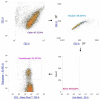TCR-Engineered Lymphocytes Targeting NY-ESO-1: In Vitro Assessment of Cytotoxicity against Tumors
- PMID: 37893178
- PMCID: PMC10604587
- DOI: 10.3390/biomedicines11102805
TCR-Engineered Lymphocytes Targeting NY-ESO-1: In Vitro Assessment of Cytotoxicity against Tumors
Abstract
Adoptive T-cell therapies tailored for the treatment of solid tumors encounter intricate challenges, necessitating the meticulous selection of specific target antigens and the engineering of highly specific T-cell receptors (TCRs). This study delves into the cytotoxicity and functional characteristics of in vitro-cultured T-lymphocytes, equipped with a TCR designed to precisely target the cancer-testis antigen NY-ESO-1. Flow cytometry analysis unveiled a notable increase in the population of cells expressing activation markers upon encountering the NY-ESO-1-positive tumor cell line, SK-Mel-37. Employing the NanoString platform, immune transcriptome profiling revealed the upregulation of genes enriched in Gene Ontology Biological Processes associated with the IFN-γ signaling pathway, regulation of T-cell activation, and proliferation. Furthermore, the modified T cells exhibited robust cytotoxicity in an antigen-dependent manner, as confirmed by the LDH assay results. Multiplex immunoassays, including LEGENDplex™, additionally demonstrated the elevated production of cytotoxicity-associated cytokines driven by granzymes and soluble Fas ligand (sFasL). Our findings underscore the specific targeting potential of engineered TCR T cells against NY-ESO-1-positive tumors. Further comprehensive in vivo investigations are essential to thoroughly validate these results and effectively harness the intrinsic potential of genetically engineered T cells for combating cancer.
Keywords: NY-ESO-1; T-cell activation; TCR; TCR-T cells; cellular cytotoxicity.
Conflict of interest statement
The authors declare no conflict of interest.
Figures








Similar articles
-
A rare population of tumor antigen-specific CD4+CD8+ double-positive αβ T lymphocytes uniquely provide CD8-independent TCR genes for engineering therapeutic T cells.J Immunother Cancer. 2019 Jan 9;7(1):7. doi: 10.1186/s40425-018-0467-y. J Immunother Cancer. 2019. PMID: 30626427 Free PMC article.
-
Exploring TCR-like CAR-Engineered Lymphocyte Cytotoxicity against MAGE-A4.Int J Mol Sci. 2023 Oct 13;24(20):15134. doi: 10.3390/ijms242015134. Int J Mol Sci. 2023. PMID: 37894816 Free PMC article.
-
Generation of effective and specific human TCRs against tumor/testis antigen NY-ESO-1 in mice with humanized T cell recognition system.Front Immunol. 2024 Dec 24;15:1524629. doi: 10.3389/fimmu.2024.1524629. eCollection 2024. Front Immunol. 2024. PMID: 39776913 Free PMC article.
-
NY-ESO-1 Based Immunotherapy of Cancer: Current Perspectives.Front Immunol. 2018 May 1;9:947. doi: 10.3389/fimmu.2018.00947. eCollection 2018. Front Immunol. 2018. PMID: 29770138 Free PMC article. Review.
-
Unleashing the immune response to NY-ESO-1 cancer testis antigen as a potential target for cancer immunotherapy.J Transl Med. 2020 Mar 27;18(1):140. doi: 10.1186/s12967-020-02306-y. J Transl Med. 2020. PMID: 32220256 Free PMC article. Review.
Cited by
-
T-regulatory cells for the treatment of autoimmune diseases.Front Immunol. 2025 Feb 4;16:1511671. doi: 10.3389/fimmu.2025.1511671. eCollection 2025. Front Immunol. 2025. PMID: 39967659 Free PMC article. Review.
-
TCR-T cell therapy: current development approaches, preclinical evaluation, and perspectives on regulatory challenges.J Transl Med. 2024 Oct 4;22(1):897. doi: 10.1186/s12967-024-05703-9. J Transl Med. 2024. PMID: 39367419 Free PMC article. Review.
-
Decoding NY-ESO-1 TCR T cells: transcriptomic insights reveal dual mechanisms of tumor targeting in a melanoma murine xenograft model.Front Immunol. 2024 Nov 26;15:1507218. doi: 10.3389/fimmu.2024.1507218. eCollection 2024. Front Immunol. 2024. PMID: 39660132 Free PMC article.
References
Grants and funding
LinkOut - more resources
Full Text Sources
Research Materials
Miscellaneous

